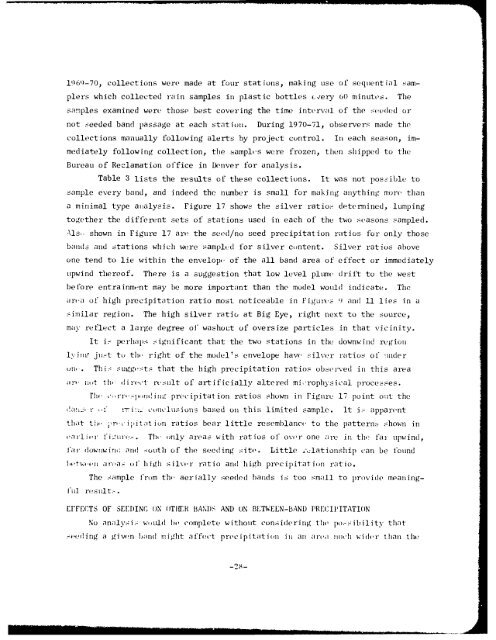pages - The Black Vault
pages - The Black Vault
pages - The Black Vault
- No tags were found...
You also want an ePaper? Increase the reach of your titles
YUMPU automatically turns print PDFs into web optimized ePapers that Google loves.
1960-70, collections were made at four stations, making use of sequential samplerswhich collected rain samples in plastic bottles •¢ery 60 minutes.<strong>The</strong>samples examined were those best covering the time interval of the seeded ornot seeded band passage at each station.During 1970-71, observers made thecollections manually following alerts by project control.In each season, immediatelyfollowing collection, the samples were frozen, then shipped to theBureau of Reclamation office inDenver for analysis.Table 3 lists the results of these collections. It was not posfible tosample every band, and indeed the number issmall for making anything more thana minimal type anialysis.Figure 17 shows the silver ratios determined, lumpingtogether the different sets of stations used in each of the two seasons sampled."Als, shown in Figure 17 are the seed/no seed precipitation ratios for only thosebands and stations which were sampled for silver content.one tend to lie within the envelop, of the allSilver ratios aboveband area of effect or immediatelyupwind thereof. <strong>The</strong>re is a suggestion that low level plume drift to the westbefore entrainment may be more important than the model would indicate.<strong>The</strong>areta of high precipitation ratio most noticeable in Figures 1) and 11 lies in asimilar region. <strong>The</strong> high silver ratio at Big Eye, right next to the source,may reflect a large degree of washout of oversize particles in that vicinity.It is perhaps significant that the two stations in the downwind regionlyijuts just to the. right of the model's envelope have silver ratios of 'tderor1,..This suggests that the high precipitation ratios observed in this areaar, not th. direrct rt-tilt of artificiallyaltered mi,'rophysicai processes.<strong>The</strong> i'rrs,,,,d inj precipitation ratios shown in Figure 17 point out theS , 7 i:i conclusion based on this limited sample. It i. apparentthat tlha. irv iuil~it ion ratios bear little resemblance to the patterns shown inearlier fi•:r. <strong>The</strong>t only areas with ratios of ove.r one are in the, fai upwind,far dowuwin,: and s-outh of the seeding site. Little zlationship can be foundl,,twe•n aroas of hit ihsilvvr ratio and high precipitatiion ratio.'ul]<strong>The</strong> sample from the aerially seeded bands isr1e.sult..EFFECTS OF SEEDINC ON OTIER BANDS AND ON BETWEEN-BAND PRECIPITATIONNo analysis would be complete without considering the po-sibility thatee _rlding a givwn b;and might affect preccipitation in an a rtimuch wider than thetoo small to provide meaning--28-





![Combat Support in Korea [270 Pages] - The Black Vault](https://img.yumpu.com/49796461/1/190x71/combat-support-in-korea-270-pages-the-black-vault.jpg?quality=85)










